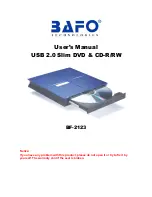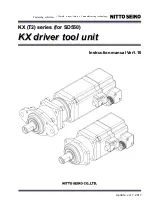
Servomotoren / Servomotors
Baugröße/Size 2 (
□
145 ) F.P 12 – 32L
Baugröße/Size 3 (
□
190 ) F.P 13 – 43L
Nr./No. 680-01975
18
4.2 Wirkungsweise und Konstruktionsmerk-
male
(Einzelteile mit Positionsangaben siehe Kap. 4.1)
4.2.1 Servomotor
LUST-Servomotoren werden gebaut und geprüft nach
DIN VDE 0530.
Der bürstenlose Motor besteht aus den aktiven Motor-
gruppen Anker (2) und Stator (1) und einem Rückmel-
desystem - Resolver (3) oder Geber (3.1). Der Resol-
ver (Hohlwellendrehmelder) arbeitet nach dem Prinzip
eines Drehtransformators. Zwei um 90° phasenver-
setzte Wicklungen erzeugen Ausgangs-spannungen,
die über den sinus- und cosinus- Phasenwinkel für die
Pollage und Drehzahl des Motors ausgewertet werden.
Der Gebertyp (3.1) kann als Inkrementalgeber oder als
Absolutwertgeber eingebaut werden. Ein sinus- und
cosinusförmiges Signal mit 1 Periode / Umdrehung
wird für die Pollage und Drehzahl des Motors ausge-
wertet. In Verbindung mit dem Resolver oder Geber
wird der Motor sinusförmig betrieben und über den
Servoverstärker digital ausgewertet.
Das Ankerfeld wird durch Permanentmagnete aus
NdFeB gebildet.
Der Servoverstärker gibt durch die Kommutierungs-
schaltung dem Motor das Verhalten einer Gleichstrom-
nebenschlußmaschine.
4.2.2 Permanent-Magnet-Bremse
Die Bremsen werden gebaut und geprüft nach DIN
VDE 0580.
Sie sind als Haltebremsen dimensioniert und dürfen
nicht als Betriebsbremsen verwendet werden (außer
”Not-Aus”-Situationen).
Im stromlosen Zustand der Bremse (60) wird der
Bremsanker (60 b) durch die Wirkung eines Perma-
nentmagneten im Bremsspulenträger (60a) reib-
schlüssig und spielfrei abgebremst.
Im stromdurchflossenen Zustand ist die Bremse ge-
lüftet. Zwischen Bremsanker (60 b) und Bremsspulen-
träger (60a) bildet sich der Arbeitsluftspalt, die Bremse
läuft frei.
4.3 Stromversorgung
4.3.1 Elektrischer Anschluß des Motors
Der Leistungsanschluß erfolgt nach Bild 9.
Der Steueranschluß vom Servoverstärker zum Motor
erfolgt entsprechend den Gebervarianten nach den
Bildern 10-12.
4.2 Mode of operation and design features
(Components with item numbers, see Chapter 4.1)
4.2.1 Servomotor
LUST servomotors are designed and tested in
compliance with the requirements of DIN VDE 0530.
The brushless motor consists of the active motor
assemblies armature (2) and stator (1) and a feedback
system - resolver (3) or encoder (3.1). The resolver
(hollow-shaft rotary resolver) operates on the rotary
transformer principle. Two windings in quadrature
generate output voltages which are evaluated via the
sine and cosine phase angle for the pole position and
motor speed. The encoder type (3.1) can be fitted as
incremental encoder or as absolute value encoder. A
sinusoidal or cosinusoidal signal with 1
period/revolution is evaluated for the pole position and
speed of the motor. In conjunction with the resolver or
encoder, the motor is operated sinusoidal and is
evaluated digitally through the servoamplifier.
The armature field is formed by permanent magnets of
NdFeB.
The servoamplifier provides the motor with the
operating characteristics of a d.c. shunt-wound
machine via the commutating circuit.
4.2.2 Permanent-magnet brake
The brakes are constructed and tested in compliance
with the requirements of DIN VDE 0580.
They are dimensioned as holding brakes and may not
be used as operating brakes (except in ”Emergency
Stop” situations). When the brake (60) is in a de-
energised state, the brake armature (60b) is retarded
through the action of a permanent magnet in the brake
coil carrier (60a) by frictional resistance and free from
backlash.
In an energized state, the brake is ventilated. Between
the brake armature (60b) and the brake coil carrier
(60a) the air gap arises; the brake runs freely.
4.3 Current supply
4.3.1 Electric connection of the motor
The output connection is made as per fig. 9.
The control connection from the servoamplifier to the
motor is made in compliance with the encoder variants
to fig. 10-12.
















































